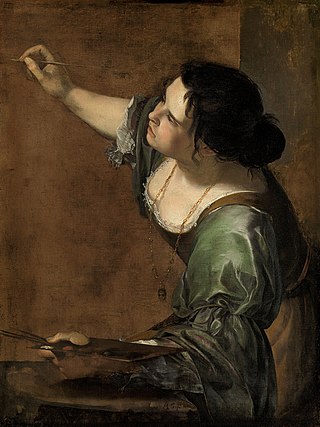
Artemisia Lomi or Artemisia Gentileschi was an Italian Baroque painter. Gentileschi is considered among the most accomplished 17th-century artists, initially working in the style of Caravaggio. She was producing professional work by the age of 15. In an era when women had few opportunities to pursue artistic training or work as professional artists, Gentileschi was the first woman to become a member of the Accademia di Arte del Disegno in Florence and she had an international clientele.

Massimo Stanzione was an Italian Baroque painter, mainly active in Naples, where he and his rival Jusepe de Ribera dominated the painting scene for several decades. He was primarily a painter of altarpieces, working in both oils and fresco. His main subject matter was biblical scenes. He also painted portraits and mythological subjects. He had many pupils and followers as his rich color and idealized naturalism had a large influence on other local artists, such as Francesco Solimena. In 1621 Pope Gregory XV gave him the title of Knight of the Golden Spur and Pope Urban VIII made him a knight of St. John around 1624 and a knight of the Order of Christ in 1627. From then on, he liked to sign his works as "EQUES MAXIMUS".
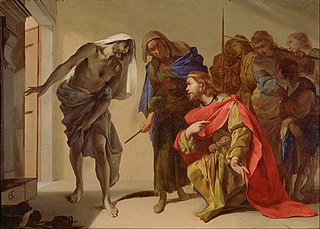
Bernardo Cavallino (1616–1656) was an Italian painter and draughtsman. He is regarded as one of the most original painters active in Naples during the first half of the 17th century.

Francesco Guarino or Guarini was an Italian painter of the Baroque period, active mainly in the mountainous area east of Naples called Irpinia, and in other areas of the Kingdom of Naples, chiefly Campania, Apulia, and Molise.

Judith Slaying Holofernes is a painting by the Italian early Baroque artist Artemisia Gentileschi, completed in 1612-13 and now at the Museo Capodimonte, Naples, Italy.
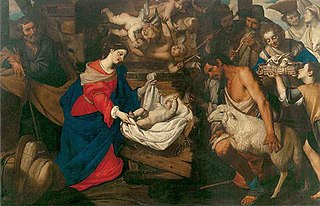
Pacecco De Rosa was an Italian painter, active in Naples.

David with the Head of Goliath is a painting by Italian Baroque artist Massimo Stanzione, created c. 1642–1643. It is now in the San Diego Museum of Art.

Susanna and the Elders is a 1610 painting by the Italian Baroque artist Artemisia Gentileschi and is her earliest-known signed and dated work. It was one of Gentileschi's signature works. She painted several variations of the scene in her career. It hangs at Schloss Weißenstein in Pommersfelden, Germany. The work shows a frightened Susanna with two men lurking above her while she is in the bath. The subject matter comes from the deuterocanonical Book of Susanna in the Additions to Daniel. This was a popular scene to paint during the Baroque period.
This is an ongoing bibliography of work related to the Italian baroque painter Artemisia Gentileschi.

Self-Portrait as a Lute Player is one of many self-portrait paintings made by the Italian baroque artist Artemisia Gentileschi. It was created between 1615 and 1617 for the Medici family in Florence. Today, it hangs in the Wadsworth Atheneum Museum of Art, Hartford, Connecticut, US. It shows the artist posing as a lute player looking directly at the audience. The painting has symbolism in the headscarf and outfit that portray Gentileschi in a costume that resembles a Romani woman. Self-Portrait as a Lute Player has been interpreted as Gentileschi portraying herself as a knowledgeable musician, a self portrayal as a prostitute, and as a fictive expression of one aspect of her identity.

Judith and Her Maidservant is one of four paintings by the Italian baroque artist Artemisia Gentileschi that depicts the biblical story of Judith and Holofernes. This particular work, executed in about 1623 to 1625, now hangs in the Detroit Institute of Arts. The narrative is taken from the deuterocanonical Book of Judith, in which Judith seduces and then murders the general Holofernes. This precise moment illustrates the maidservant Abra wrapping the severed head in a bag, moments after the murder, while Judith keeps watch. The other three paintings are now shown in the Museo di Capodimonte in Naples, the Palazzo Pitti in Florence, and the Musée de la Castre in Cannes.

Self-Portrait as a Female Martyr, is also known as the Self-Portrait as a Martyr Saint. This painting was created by the Italian female artist, Artemisia Gentileschi. This self-portrait was made around 1615 depicting the artist herself as a martyr. It is one of two paintings by Gentileschi painted with oil on a wood panel. This self-portrait is currently in a private collection in the United States.

Lucretia is a painting by the Italian baroque artist Artemisia Gentileschi. It depicts Lucretia, the wife of Roman consul and general Collatinus, at the moment of her suicide. The decision to take her own life was made after she was blackmailed and raped by Sextus Tarquinius, a fellow soldier of Collatinus. It is one of a number of paintings of Gentileschi that focus on virtuous women ill-treated by men.

The Birth of Saint John the Baptist, by Artemisia Gentileschi, was part of a six-painting portrayal of Saint John's life, with four of the paintings by Massimo Stanzione and one by Paolo Finoglia, for the Hermitage of San Juan Bautista on the grounds of Buen Rierto in Madrid, under orders from the Viceroy of Naples, the Conde de Monterrey. Although a date has not been agreed upon by scholars, Artemesia most likely painted The Birth of Saint John the Baptist between 1633 and 1635. It is one of the most renowned works from Artemisia's Naples period, especially due to its detailed rendering of fabrics and floor tiles.

Judith Slaying Holofernes c. 1620, now at the Uffizi Gallery in Florence, is the renowned painting by Baroque artist Artemisia Gentileschi depicting the assassination of Holofernes from the apocryphal Book of Judith. When compared to her earlier interpretation from Naples c. 1612, there are subtle but marked improvements to the composition and detailed elements of the work. These differences display the skill of a cultivated Baroque painter, with the adept use of chiaroscuro and realism to express the violent tension between Judith, Abra, and the dying Holofernes.
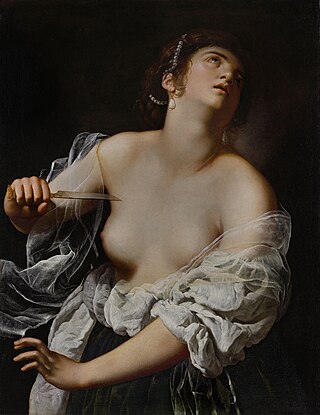
Lucretia is a painting by the seventeenth-century Italian artist Artemisia Gentileschi. It is one of three paintings that Gentileschi painted of Lucretia, the wife of Roman consul and general Tarquinus, at the moment of her suicide. The other two versions are in a private collection in Milan and Potsdam, whilst a work in the Museo di Capodimonte in Naples of the same subject previously attributed to Gentileschi is now attributed by its owner to Massimo Stanzione.

Clio, Muse of History is a painting by the baroque painter Artemisia Gentileschi. It was painted around 1632, just after Artemisia had moved to Naples. It currently hangs in the Palazzo Blu, Pisa. The painting has been interpreted in relationship to Gentileschi's own career and self-image - "by including her signature in Clio's open book, Artemisia was quite literally writing herself into history". In stylistic terms, the painting demonstrates Gentileschi's borrowing from Venetian styles of painting where she "applied her colors in a free and more spontaneous fashion."
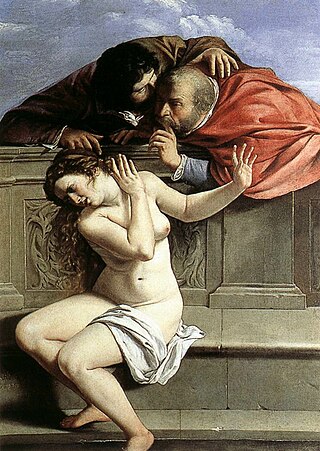
Susanna and the Elders is an Old Testament story of a woman falsely accused of adultery after she refuses two men who, after discovering one another in the act of spying on her while she bathes, conspire to blackmail her for sex. Depictions of the story date back to the late 3rd/early 4th centuries and are still being created.

Annunciation is a painting by the Italian artist Artemisia Gentileschi. It is signed and dated 1630.

Cleopatra is a painting by the Italian baroque artist Artemisia Gentileschi, completed in the mid-1630s. It is owned by a private collection in Rome.



















